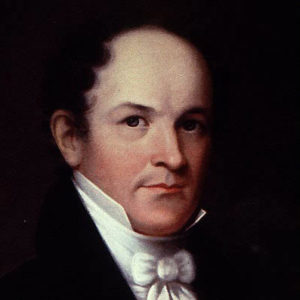calsfoundation@cals.org
Thomas Nuttall (1786–1859)
Thomas Nuttall, a preeminent and far-ranging field naturalist, participated in the early scientific exploration of Arkansas and is remembered both for identifying a number of the state’s plants and for his description of early Arkansas life. His notes on people living in the territory—both Native Americans and American settlers—have provided valuable information for historians and researchers ever since they were first published in 1821.
Thomas Nuttall was born to James Nuttall and Margaret Hardacre Nuttall on January 5, 1786, in Long Preston, Yorkshire, England. He was the oldest of three siblings; he had two sisters, Susan (Susannah) and Elizabeth. He never married and had no children.
After attending the village school, Nuttall worked as a journeyman printer for his uncle in Liverpool. Suffering ill health, he recuperated in Long Preston, at which time Nuttall was introduced to botany by his friend John Windsor. By 1807, Nuttall had finished his apprenticeship and, breaking with his uncle over a desire to pursue the natural sciences in North America, spent a period of time in London. In March 1808, he sailed from Liverpool to Philadelphia, Pennsylvania. Nuttall embarked on an expedition to the Great Lakes in 1810 and, a year later, was part of William Price Hunt’s Astor Expedition that ascended the Missouri River. The impending War of 1812 caused Nuttall to voyage to England, but he returned to the United States in 1815, traveling through the southeast and publishing The Genera of North American Plants, and a Catalogue of the Species, to the Year 1817 three years later.
In 1818, sponsored by four members of the American Philosophical Society, Nuttall began his exploration of Arkansas and the old southwest, traveling to Pittsburgh, Pennsylvania, and Cincinnati, Ohio, and purchasing a flatboat at Louisville, Kentucky, to descend the Mississippi River. In January 1819, after difficulties in getting his vessel through the White River cutoff to the Arkansas River, Nuttall arrived at Arkansas Post (Arkansas County) where he sold his boat and cargo. Nuttall not only hoped to reach the Rocky Mountains but even entertained the idea of subsequently extending his research to the Gulf Coast, if he could obtain his sponsors’ support. His immediate plan was to proceed up the Canadian River to the mountains, descending by the Red River. Failing in his attempt to send his baggage on separately so that he could walk across the Grand Prairie, Nuttall accompanied it to Belle Point (Fort Smith) in a series of boat rides on the Arkansas River.
While traveling up the Arkansas River, Nuttall visited Arkansas Post as well as the settlement that would become Little Rock (Pulaski County), the settlement of Cadron (Faulkner County), and a Cherokee settlement in the area of what would later be Dardanelle (Yell County). He observed and wrote about Quapaw and Osage dwellings and customs, and also remarked upon the uneducated and unsophisticated manners of the American settlers. Nuttall noted the cultivation of cotton and rice near Arkansas Post, and he also mentioned deposits of coal in the Arkansas Valley of western Arkansas. He made many notes regarding plants and animals of the territory, as well as its geography. He was particularly impressed by Maumelle Mountain (now called Pinnacle Mountain) west of Little Rock and by Mount Nebo (confusingly called Mount Magazine at the time). Nuttall wrote that the mountains of western Arkansas were similar, in his opinion, to the Appalachian Mountains of Pennsylvania.
During May, Nuttall accompanied a military patrol tasked with removing white settlers from Indian lands to the Red River; separated from his companions, he waited until June to return in safety with another party. In July and August, he moved upriver to its confluence with the Verdigris, making many observations of Osage activities. He then joined forces with a trapper named Lee in an attempt to reach the Rockies by way of the Cimarron. Traveling overland, Lee and Nuttall had reached a stream flowing into the North Fork of the Canadian River when Nuttall developed a fever. While the travelers eventually reached the Cimarron, the death of Lee’s horse in quicksand caused them to abandon any further advance and instead return to Belle Point. Here, Nuttall remained in a weakened state until mid-October, at which time he continued downriver to Arkansas Post, and eventually to Natchez, Mississippi, and New Orleans, Louisiana.
The Yellowstone Expedition of 1819, led by Major Stephen Harriman Long, followed the Canadian Fork of the Arkansas River rather than its Red River objective by mistake, and so traversed much of the area of Arkansas that Nuttall had covered in his trip. This undoubtedly spurred Nuttall to write up his own expedition’s accomplishments, which was published as A Journal of Travels into the Arkansas Territory during the year 1819, with occasional Observations on the Manners of the Aborigines (1821). (A projected second volume on Native American antiquities and languages never appeared.) Nuttall’s trip resulted in the collection of some 300 new species of plants and helped establish his reputation as a seminal American naturalist. His book, favorably reviewed when it appeared, is today regarded as a classic of frontier writing and a valuable source on frontier settlements and early Arkansas history.
In 1822, Nuttall was appointed curator of the Botanic Garden in Cambridge, Massachusetts, and while there was also employed as a lecturer in natural history at Harvard University, despite his lack of an academic degree. Nuttall subsequently worked, not entirely happily, at Philadelphia’s Academy of Natural Sciences. The death of his aunt in 1841 necessitated a return to England to fulfill the terms of an inheritance from his uncle, which generally required nine months of residence there each year. Nuttall subsequently made only one more visit to the East Coast of America (during 1847–48).
Despite minor scientific spats during the course of Nuttall’s career, it is clear that his contributions to science were generally valued by scientific contemporaries. Charles Wilkins Short wrote that American botanists were in Nuttall’s debt. Nuttall was described as “one of the most indefatigable and judicious of the botanists who have studied the North American flora.”
Not all assessments of Nuttall’s career were positive, however. Some explorers who traveled with him deplored the manner in which he ruined his rifle, using it as a tool to dig up plant samples. A 1979 book of humorous anecdotes, The Incomplete Book of Failures, begins with an account of Nuttall as “The Least Successful Explorer.” It notes that Nuttall was frequently lost during the course of his expeditions, and that he once fled from a search party for three days, mistaking them for hostile Indians. On another occasion, the book notes, Nuttall was lost for so long that he collapsed with exhaustion; an Indian took pity on him, carried him three miles to a river, and brought him back to camp by canoe.
On September 10, 1859, Nuttall died from an attack of chronic bronchitis at Nutgrove, St. Helens, Lancashire; his death certificate also listed acute gastritis, from which he had been suffering for six months, as a cause of death.
For additional information:
Beidleman, Richard G. “The 1818–20 Arkansas Journey of Thomas Nuttall.” Arkansas Historical Quarterly 15 (Autumn 1956): 249–259.
Graustein, Jeannette E. Thomas Nuttall, Naturalist: Explorations in America, 1808–1841. Cambridge, MA: Harvard University Press, 1967.
Grout, Andrew. “Nuttall, Thomas.” In Oxford Dictionary of National Biography, vol. 41: Norbury–Osborn, edited by H. C. G. Matthew and Brian Harrison. New York: Oxford University Press, 2004.
Lawson, Russell M. The Land between the Rivers: Thomas Nuttall’s Ascent of the Arkansas, 1819. Ann Arbor: University of Michigan Press, 2004.
Milson, Andrew J. Arkansas Travelers: Geographies of Exploration and Perception, 1804–1834. Fayetteville: University of Arkansas Press, 2019.
Mosenthin, H. Glenn. “Thomas Nuttall’s 1819 Observations of Arkansas Post.” Grand Prairie Historical Bulletin 63 (April 2020): 36–46.
Nuttall, Thomas. A Journal of Travels into the Arkansas Territory during the Year 1819. Edited by Savoie Lottinville. Fayetteville: University of Arkansas Press, 1999.
Pile, Stephen. The Incomplete Book of Failures. New York: E. P. Dutton, 1979.
Vaulx, Julia R. “Another Early Traveler in Arkansas.” Arkansas Historical Quarterly 5 (Summer 1946): 169–178.
Samuel Pyeatt Menefee
Charlottesville, Virginia
Staff of the CALS Encyclopedia of Arkansas
 Literature and Authors
Literature and Authors Thomas Nuttall
Thomas Nuttall 




The landform called the Magazine Mountain in Nuttall’s day was our Mount Nebo. Present-day Mount Magazine was then known as Casse Tete or Tomahawk Mountain, and the names were not changed until after the Civil War, when the ladies of Dardanelle renamed the mountain Mount Nebo. Nuttall’s drawing in his Journal of Travels is clearly Mount Nebo.